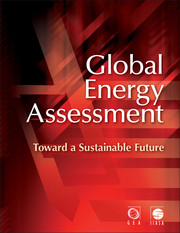Book contents
- Frontmatter
- Contents
- Section 1
- Section 2
- Section 3
- Cluster 1
- Cluster 2
- Cluster 3
- Cluster 4
- Chapter 22 Policies for Energy System Transformations: Objectives and Instruments
- Chapter 23 Policies for Energy Access
- Chapter 24 Policies for the Energy Technology Innovation System (ETIS)
- Chapter 25 Policies for Capacity Development
- Section 4
- Index
- References
Chapter 22 - Policies for Energy System Transformations: Objectives and Instruments
Published online by Cambridge University Press: 05 September 2012
- Frontmatter
- Contents
- Section 1
- Section 2
- Section 3
- Cluster 1
- Cluster 2
- Cluster 3
- Cluster 4
- Chapter 22 Policies for Energy System Transformations: Objectives and Instruments
- Chapter 23 Policies for Energy Access
- Chapter 24 Policies for the Energy Technology Innovation System (ETIS)
- Chapter 25 Policies for Capacity Development
- Section 4
- Index
- References
Summary
Executive Summary
The Global Energy Assessment (GEA) emphasizes the importance of energy to all societies, which explains a longstanding tendency for governments to be closely involved in the energy sector. The nature and extent of this involvement – the degree and types of energy-related policies – depends on a government's ideological orientation, the particular energy resource endowment in its jurisdiction, the development level of its economy, and specific concerns of its society with respect to energy access, energy security, and the environmental and human health impacts of energy supply and use.
In every country, energy's critical role for the goal of sustainable development is widely acknowledged. This means that energy-related policies need to be assessed in terms of performance with respect to the social, economic, and environmental dimensions that are encompassed by the concept of sustainable development. Ideally, energyrelated policies will make advances with respect to all three of these critical sustainability dimensions. But frequently policymakers are faced with difficult trade-offs in which improvement in one dimension is at the cost of another. Thus, the first goal of energy-related policy design should be to seek win-win opportunities for simultaneously advancing social, economic, and environmental goals. When this is not possible, the goal should be to apply decision-support mechanisms that integrate diverse social objectives and values into the policy design process, such as the application of multi-criteria analysis as described by Munasinghe (1992; 2009).
- Type
- Chapter
- Information
- Global Energy AssessmentToward a Sustainable Future, pp. 1551 - 1602Publisher: Cambridge University PressPrint publication year: 2012
References
- 2
- Cited by



